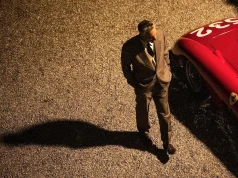A director only makes one movie in his life,” said filmmaker Jean Renoir. “Then he breaks it up and makes it again.”
That quote applies to many who step behind the camera, but fits few quite as snuggly as it does the enigmatic child of cinema, the French auteur, Leos Carax.
Carax was born Alexander Dupont — his stage name is an anagram of “Alex” and “Oscar” — in 1960 when the French New Wave was just beginning to take hold, and it is with that spirit that Carax has engaged, intrigued, challenged and entertained audiences with five features and three shorts. Not a prolific body of work, but an impressive one.
Yet, despite the quality and acclaim, Carax is still largely unknown in the States, which makes the Sie Film Center’s programming on Jan. 10 all the more special. For one night only, the Sie will run a special Carax triple-feature: Mr. X, Boy Meets Girl and Mauvais Sang.
Entering the cinema of Carax is not easy. His work is riddled with allusions, citations, quotations and playful tangents. Thankfully, the Sie is opening the evening with a 2014 documentary about Carax, Mr. X from director Tessa Louise-Salomé. Mr. X collects interviews from actors, technicians and critics to give background and insight into the life and mind of Carax. The documentary is largely spoiler free — not that it would really matter — and provides a nice primer for the following films.
Carax’s 1984 debut, Boy Meets Girl, is the perfect example of a first film: at times uneven and derivative, yet full of life and energy. As Times critic Vincent Canby wrote, “Mr. Carax is 24, but Boy Meets Girl looks like the work of a talented 18-year-old, someone who still spends more time inside the Cinémathèque Française than outside it.”
Indeed, Carax was a student of the cinema, but Boy Meets Girl, with all of its allusions and references to romantic Hollywood cinema and the French New Wave, actually laid down the groundwork for what would become Carax’s 30-plus year career in cinema. Starring Denis Lavant (who would go on to star in four of Carax’s features) and cinematography by Jean-Yves Escoffier (who went on to lens Carax’s next two projects), Boy Meets Girl has a texture that is unlike its many counterparts. The movie is aimless while relentlessly hurtling toward its shocking conclusion.
Made only two years later, Mauvais Sang is already the work of a mature director. Leaving behind the grainy, black-and-white aesthetic, Carax opted for expressive color photography and sound stages, yielding a more artificial flavor but allowing Carax and Escoffier greater control over the collision of light and shadow. Mauvais Sang doesn’t just show a greater use of expressionism, it also favors the poetic over conventional narrative. Neither of these movies is about plot points and story structure, but the broadest strokes possible. Ultimately, they are about boys meeting girls, but in between there are moments of dance, gangsters, firearms, skydiving, discussions of cinema and David Bowie. For Carax, it’s all the same.
Respond: [email protected]














